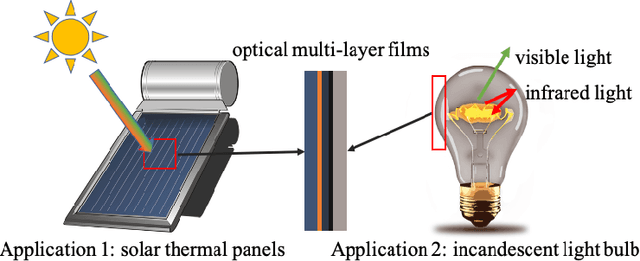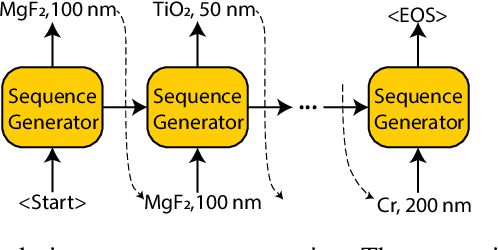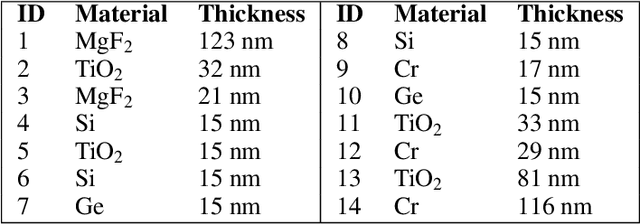L. Jay Guo
OL-Transformer: A Fast and Universal Surrogate Simulator for Optical Multilayer Thin Film Structures
May 19, 2023Abstract:Deep learning-based methods have recently been established as fast and accurate surrogate simulators for optical multilayer thin film structures. However, existing methods only work for limited types of structures with different material arrangements, preventing their applications towards diverse and universal structures. Here, we propose the Opto-Layer (OL) Transformer to act as a universal surrogate simulator for enormous types of structures. Combined with the technique of structure serialization, our model can predict accurate reflection and transmission spectra for up to $10^{25}$ different multilayer structures, while still achieving a six-fold time speedup compared to physical solvers. Further investigation reveals that the general learning ability comes from the fact that our model first learns the physical embeddings and then uses the self-attention mechanism to capture the hidden relationship of light-matter interaction between each layer.
OptoGPT: A Foundation Model for Inverse Design in Optical Multilayer Thin Film Structures
Apr 20, 2023Abstract:Foundation models are large machine learning models that can tackle various downstream tasks once trained on diverse and large-scale data, leading research trends in natural language processing, computer vision, and reinforcement learning. However, no foundation model exists for optical multilayer thin film structure inverse design. Current inverse design algorithms either fail to explore the global design space or suffer from low computational efficiency. To bridge this gap, we propose the Opto Generative Pretrained Transformer (OptoGPT). OptoGPT is a decoder-only transformer that auto-regressively generates designs based on specific spectrum targets. Trained on a large dataset of 10 million designs, our model demonstrates remarkable capabilities: 1) autonomous global design exploration by determining the number of layers (up to 20) while selecting the material (up to 18 distinct types) and thickness at each layer, 2) efficient designs for structural color, absorbers, filters, distributed brag reflectors, and Fabry-Perot resonators within 0.1 seconds (comparable to simulation speeds), 3) the ability to output diverse designs, and 4) seamless integration of user-defined constraints. By overcoming design barriers regarding optical targets, material selections, and design constraints, OptoGPT can serve as a foundation model for optical multilayer thin film structure inverse design.
Automated Optical Multi-layer Design via Deep Reinforcement Learning
Jun 21, 2020



Abstract:Optical multi-layer thin films are widely used in optical and energy applications requiring photonic designs. Engineers often design such structures based on their physical intuition. However, solely relying on human experts can be time-consuming and may lead to sub-optimal designs, especially when the design space is large. In this work, we frame the multi-layer optical design task as a sequence generation problem. A deep sequence generation network is proposed for efficiently generating optical layer sequences. We train the deep sequence generation network with proximal policy optimization to generate multi-layer structures with desired properties. The proposed method is applied to two energy applications. Our algorithm successfully discovered high-performance designs, outperforming structures designed by human experts in task 1, and a state-of-the-art memetic algorithm in task 2.
 Add to Chrome
Add to Chrome Add to Firefox
Add to Firefox Add to Edge
Add to Edge